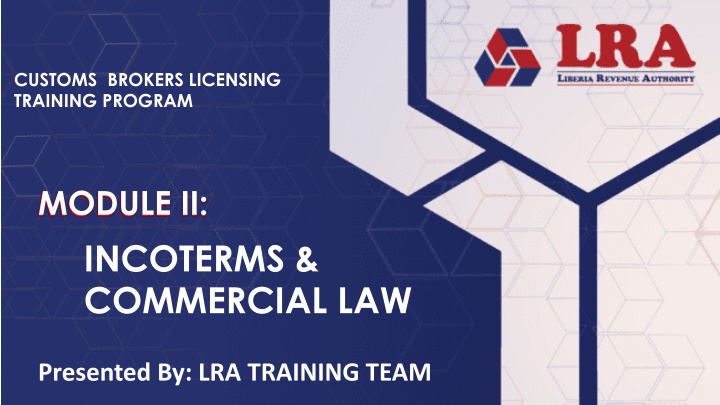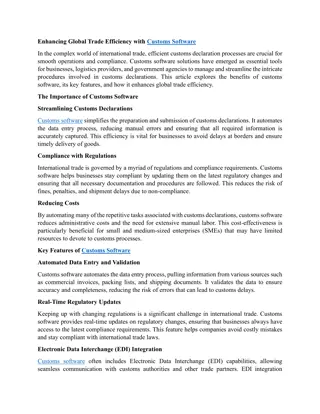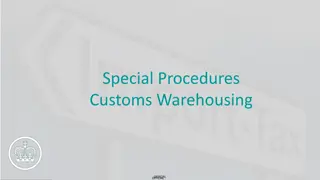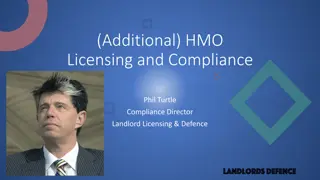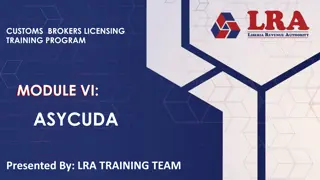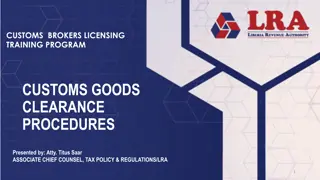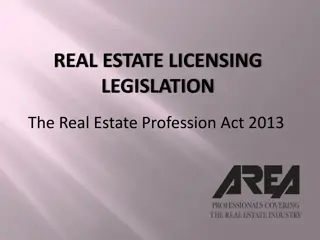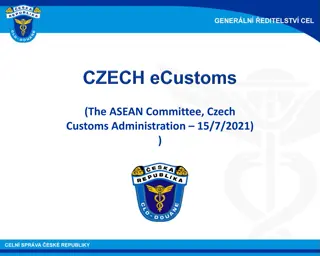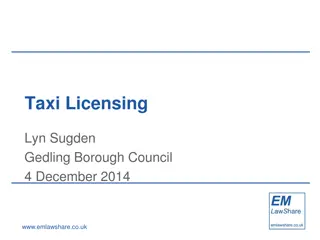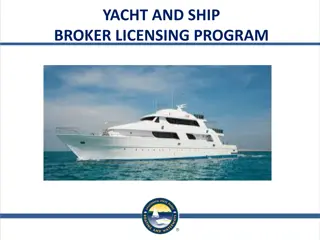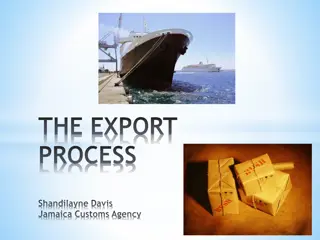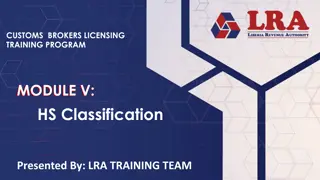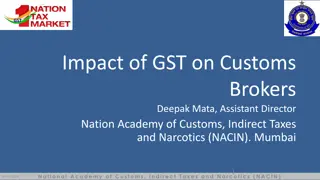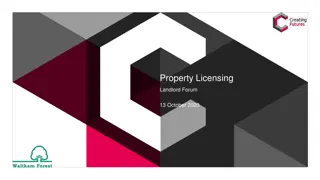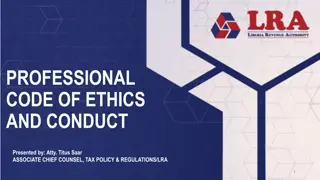Customs Brokers Licensing Training Program Module II: Incoterms & Commercial Law
This module focuses on the purpose and structure of Incoterms, the international contract of sales, key elements of a binding contract, and issues to consider when contracting for the international sale of goods. Participants will enhance their knowledge and skills to succeed in the Customs Brokers Licensing examination. Failure to excel in this module could hinder becoming a licensed professional Customs broker.
Download Presentation

Please find below an Image/Link to download the presentation.
The content on the website is provided AS IS for your information and personal use only. It may not be sold, licensed, or shared on other websites without obtaining consent from the author.If you encounter any issues during the download, it is possible that the publisher has removed the file from their server.
You are allowed to download the files provided on this website for personal or commercial use, subject to the condition that they are used lawfully. All files are the property of their respective owners.
The content on the website is provided AS IS for your information and personal use only. It may not be sold, licensed, or shared on other websites without obtaining consent from the author.
E N D
Presentation Transcript
CUSTOMS BROKERS LICENSING TRAINING PROGRAM MODULE II: INCOTERMS & COMMERCIAL LAW Presented By: LRA TRAINING TEAM
MODULEOUTLINE 1. Introduction 2. Module objectives 3. Session I Outline 4. Session I objectives 5. Brief History of Incoterms 6. Terms organization 7. What is international contract of sales? 8. Key elements of binding contract 9. Composition of Vienna Sales Convention (VSC)
MODULEOBJECTIVES At the end of module, the participants will be able to: 1. Discuss the purpose of Incoterms 2. Identify the groups/structure of Incoterms 3. List the trade terms 4. Demonstrate the use of Incoterms chart 5. Explain the purpose of contract for international sale of goods 6. Explain the key elements of contract for international sale of goods 7. Discuss the key issues to consider in contracting
INTRODUCTION This module attempts to present the rational for the alignment of appropriate International Commercial terms (Incoterms)in International contract laws for the movement of cargos across borders.
INTRODUCTION CONT. The participants in this course are entreated to do their utmost best to enhance their knowledge and skills to make them efficient and active participants and to contribute effectively to the conduct of the class session. This may lead to a successful pass in the Customs Brokers Licensing uniform examination.
INTRODUCTION CONT. On the other hand, participants who may not assert themselves proficiently in this module, could stand the risk of not passing the uniform examination and may fail to be licensed to practice as professional Customs broker.
SESSION I INTERNATIONAL COMMERCIAL TERMS (INCOTERMS)
SESSION OUTLINE 1. Session Objectives 2. Introduction 3. Division of Incoterms 4. Brief history of Incoterms 5. Dos and Don ts of Incoterms 6. The organization of Trade Terms 7. Incoterms Chart
SESSION OBJECTIVES At the end of the session, the participants will be able to: Discuss the formation of Incoterms List the Incoterms Identify the terms by groups/structure Discuss the terms according parts Explain the terms according to level of risk bear by each party Demonstration the use of Incoterms chart
INTRODUCTION Incoterms are series of internationally recognized standardized trade terms published by the International Chamber of Commerce (ICC) and widely used in international sales. They cover issues like who does what, who pays for what and when risk in the goods passes from seller to buyer. Also, when delivery occurs, as well as matters such as insurance, export and import clearance and the division of other costs pertaining to the delivery of goods. These are determinant factors in the valuation process of goods. Hence, brokers need to be knowledgeable of incoterms.
BRIEF HISTORY ICC introduced Incoterms in 1936 & are revised every 10 years They were 13, but now simplified to 11 terms Incoterms comprises 3 English language letters acronym The current version is Incoterms 2010 Exclusively used in sales/purchase contract Updated to reflect current trade practice Written to reflect rather than dictate trade practice Always accompanied by a geographic place (the more precise the be better).
TABULAR SUMMARY -INCOTERMS Departure from ware- house Main transportation not paid by the seller Shipping charges paid by the seller until reaching destination point SPECIFICATIONS Main transportation paid by the seller Incoterm / Cost Packaging Loading from warehouse Pre-carriage Export customs clearance EXW FCA FAS FOB CIP CIF CPT CIP DAT DAP DDP S S S S S S S S S S S B S S S S S S S S S S B S S S S S S S S S S B S S S S S S S S S S Handling at departure B B B S S S S S S S S Main transportation B B B B S S S S S S S Transportation insurance Handling at arrival Import customs clearance Post-carriage Unloading into warehouse S* S* S* B B B B B S B S B B B B B B B B S S S B B B B B B B B B B S B B B B B B B B B B S B B B B B B B B B B S
THE DOs OF INCOTERMS Divide costs, risks and responsibilities between sellers and buyers. Guide one or the other party into subsidiary contracts required to fulfill designated tasks such as contracts of carriage and contracts of insurance.
THE DONTs OF INCOTERMS Address passage of title. Address recognition of revenue. Address remedies for breach of contract. Address more than one contract (drop shipments). Note: They are not law, but they must be specified in order to apply. Not All inclusive, they cannot address such issues as customary operations of carriers, ports, trades, government regulations, etc.
TERMS ORGANIZATION Incoterms are organized into: 4 TERMS GROUPS (b4 2010) 1. Departure (E) 2. Main Carriage unpaid (C) 3. Main Carriage Paid (F) 4. Arrival (D) 3 PARTS 1. Part I 2. Part II 3. Part II 2 TRANSPORT MODES (2010) 1. Any Transport Mode 2. Maritime Transport Mode
MARITIME TRANSPORT MODE There are 4 terms in this mode as follow: 1. Free Alongside Ship (FAS) 2. Free on Board (FOB) 3. Cost and Freight (CRF) 4. Cost, Insurance and Freight (CIF)
RECOMMENDED FOR CONTAINERS CARGOS 1. FOB = FCA 2. CRF = CPT 3. CIF = CIP
PART I-III OF INCOTERMS 1. PART I Comprises of D and F groups (EXW, FAS, FCA & FOB) 2. PART II Incorporates only the C group terms (CPT, CRF, CIF & CIP) 3. PART III incorporates only D group terms (DAT, DAP & DDP) 4 terms replaced in 2010 (DEF, DES, DDU & DEQ) only in this group
CHANGES IN INCOTERMS 2010 DAT (delivered at Destination) - Delivered at a named place, at buyer s disposal, unloaded - Replaces DEQ DAP (delivered at place) - Delivered at a named place, at buyer s disposal, not unloaded - Replaces DAF, DES, DDU Guidance notes - Explain fundamentals, usage, risk, cost, etc.
CHANGES IN INCOTERMS 2010 cont. Rules for Any Mode of Transport - EXW, FCA, CPT, CIP, DAT, DAP, DDP Rules for Sea and Inland Waterway Transport - FAS, FOB, CFR, CIF Electronic Communication - Electronic means of communication now given same effect as paper as long as parties agree or where customary Security-Related Clearances - Rules now allocate responsibility for these
CHANGES IN INCOTERMS 2010 cont. String Sales - Rules now recognize that seller may fulfill its obligations by procuring goods that have been shipped Terminal Handling Charges - Now specifically allocated so that buyer is not charged twice (seller and terminal)
ANY TRANSPORT MODE TERMS There are 7 Terms in this mode as Follow: 1. Ex-Work (EX) 2. Free Carrier (FCA) 3. Carrier Paid To (CPT) 4. Carriage and Insurance Paid To (CIP) 5. Deliver at Terminal (DAT) 6. Deliver at Place (DAP) 7. Deliver Duty Paid (DDP)
Seller Buyer ??? Seller delivers when he/she places the goods at the disposal of buyer at the seller s premises or another named place (i.e. works, factory, warehouse, etc.).
EX-WORKScont. Seller does not need to load the goods on any collecting vehicle, nor does it need to clear the goods for export, where such clearance is applicable. Fewest up front requirements for seller - Example: Ex works [factory] Beer factory, Monrovia- Liberia (Incoterms 2010) or - 2,000, 000 liters of raw rubber at $500,000.00 EXW, Firestone warehouse, Freeport of Monrovia-Liberia
Free Carrier (FCA) Seller delivers the goods to the carrier or another person nominated by the buyer at the seller s premises or another named place. The parties are well advised to specify as clearly as possible the point within the named place of delivery, as the risk passes to the buyer at that point. Seller does clear goods for export; import formalities are buyer s responsibility Seller may contract for carriage at buyer s expense and risk
Free Carrier (FCA) cont. Seller s delivery options - If the named place is seller s premises: seller must load goods onto buyer s means of transport - If the named place is any other place: seller must place the goods at buyer s (or his carrier s disposal) on seller s mode of transport (ready for unloading) Seller has no control over carrier, insurance, etc. Improvements over Ex Works - Seller clears goods for export - Can be used to require seller to load goods, when seller is in a better position to do so
Carriage Paid To (CPT) Seller delivers the goods to the carrier or another person nominated by the seller at an agreed place (if any place is agreed between the parties) and the seller must contract for and pay the costs of carriage necessary to bring the goods to the named place of destination 2 Key points Place of delivery of goods to carrier - Seller s delivery obligation is complete - Risk of loss passes Place of destination - Seller contracts for and pays for carriage to the place of destination
Carriage Paid To (CPT) cont. . Seller clears goods for export and pays for transport Seller pays for both loading and unloading if covered by contract of carriage Seller has no obligation to pay for insurance but must provide buyer information to buy insurance at buyer s risk and expense Buyer obtains import licenses and carries out customs formalities
Carriage Paid To (CPT) cont. EXAMPLE Contract says seller is to deliver goods to shipping warehouse in Freeport, Terms of sale are CPT buyer s facility, 10 Wills Place, #5, Tema Port, Ghana 0387108 (Incoterms 2010). Delivery obligation is fulfilled when seller delivers to the shipping facility in Freeport. Risk of loss passes at the moment the goods are handed over to the carrier in Freeport. But seller pays for carriage to Ghana
CARRIAGE AND INSURANCE PAID TO (CIP) Seller delivers the goods to the carrier or another person nominated by the seller at an agreed place; seller must contract for and pay the costs of carriage necessary to bring the goods to the named place of destination Insurance requirement is minimum cover (institute cargo clause c) in the amount of contract price plus 10% from point of delivery to point of destination Buyer may pay for additional coverage (institute cargo clauses a or b); seller must provide the information necessary to allow buyer to do so
Seller Buyer Carriage & Insurance Paid To (CIP) Responsibility Pays Transport Insures goods
DELIVER AT TERMINAL (DAT) Seller delivers when the goods, once unloaded from the arriving means of transport, are placed at the disposal of the buyer at a named terminal at the named port or place of destination. Terminal includes any place, whether covered or not, such as a quay, warehouse, container yard or road, rail or air cargo terminal. The seller bears all risks involved in bringing the goods to and unloading them at the terminal at the named port or place of destination.
DELIVER AT TERMINAL (DAT) cont. Seller s obligation is fulfilled and risk of loss passes at same time: when the goods are unloaded at the arriving terminal and placed at buyer s disposal Can specify a point within the terminal at which time the obligation is complete Seller clears goods for export but not for import No requirement for insurance
DELIVERED AT PLACE (DAP) Seller delivers when the goods are placed at the disposal of the buyer on the arriving means of transport ready for unloading at the named place of destination. The seller bears all risks involved in bringing the goods to the named place. Goods are placed at buyer s disposal at named location ready for unloading; risk passes at that point No obligation for insurance
DELIVERED AT PLACE (DAP) (cont.) Much like DAT, but with additional obligation by seller into country of delivery Seller clears goods for export but not import (use DDP if intent is to require seller to clear goods for import also).
Delivered Duty Paid (DDP) Seller delivers the goods when the goods are placed at the disposal of the buyer, cleared for import on the arriving means of transport ready for unloading at the named place of destination. The seller bears all the costs and risks involved in bringing the goods to the place of destination and has an obligation to clear the goods for export and import, to pay all duty/taxes for both export and import and to carry out all customs formalities.
Delivered Duty Paid (DDP) cont. Like DAP, but including seller s obligation to clear goods for import pay for any necessary licenses Maximum obligation for seller If seller is not well-suited to clear goods for import, DAP should be used No obligation to pay for insurance
Seller Buyer Delivered Duty Paid (DDP) Responsibility Pays Transport Insures goods ???
MARITIME TRANSPORT MODE There are 4 terms in this mode as follow: 1. Free Alongside Ship (FAS) 2. Free on Board (FOB) 3. Cost and Freight (CRF) 4. Cost, Insurance and Freight (CIF)
FREE ALONGSIDE SHIP (FAS) Seller delivers when the goods are placed alongside the vessel (e.g., on a quay or a barge) nominated by the buyer at the named port of shipment. The risk of loss of or damage to the goods passes when the goods are alongside the ship, the buyer bears all costs from the moment onwards. Seller is obligated to clear goods for export but not import Can be used in a string sale where seller procures goods already delivered for shipment
FREE ALONGSIDE SHIP (FAS) cont. Not appropriate when goods in container and delivered to carrier at terminal; FCA recommended. Seller has no obligation to pay for contracts of carriage or insurance but may contract for carriage and must assist buyer by providing necessary information for insurance Example: FAS BMC pier, Freeport, Liberia (incoterms 2010)
FREE ON BOARD (FOB) Seller delivers the goods on board the vessel nominated by the buyer at the named port of shipment or procures the goods already so delivered. The risk of loss of or damage to the goods passes when the goods are on board the vessel, and the buyer bears all costs from that moment onwards. Another change in 2010: if requested by buyer or if it is a commercial practice and buyer does not instruct otherwise, seller may contract for carriage at buyer s risk and expense; seller may decline but must notify buyer promptly.
FREE ON BOARD (FOB) cont. Free on board, no longer means across the ship s rail; now means on board the vessel- innovation of Incoterms 20110. Like FAS, but goods must be placed on board the vessel/boat Example: FOB Harper (Incoterms 2010)
COST AND FREIGHT (CRF) Seller delivers the goods on board the vessel or procures the goods already so delivered. The risk of loss of or damage to the goods passes when the goods are on board the vessel. The seller must contract for and pay the costs and freight necessary to bring the goods to the named port of destination Seller clears goods for export but not import
COST AND FREIGHT (CRF) cont. 2 places of importance Place of delivery of goods - Seller s delivery obligation is fulfilled when goods are on board the vessel - Risk of loss passes when the goods are on board the vessel Port of destination - Seller pays for carriage to port of destination Seller has no obligation to obtain insurance
COST AND FREIGHT (CRF) cont. Seller pays for unloading if the contract of carriage covers unloading If intent to ship in containers and delivery is to carrier other than vessel, use CPT Example: Contract says: Seller is to deliver goods on board vessel at Port of Buchanan, G/Bassa, Liberia. Terms of sale are: CFR, Freetown (Incoterms 2010).
COST AND FREIGHT (CRF) cont. Example: - Seller s delivery obligation is fulfilled when the goods are on board the vessel in Buchanan; risk of loss passes then also - Seller must pay for shipment to Freeport Contract says terms of sale are: CFR, Freeport (Incoterms 2010). Silent as to port of shipment - Seller s delivery obligation is fulfilled when the goods are on board the vessel in the port selected by seller; risk of loss passes then also - Seller must pay for shipment to Freetown
COST INSURANCE AND FREIGHT (CIF) Seller delivers the goods on board the vessel or procures the goods already so delivered. The risk of loss of damage to the goods passes when the goods are on board the vessel. The seller must contract for and pay the costs and freight necessary to bring the goods to the named port of destination
COST INSURANCE AND FREIGHT (CIF) cont. Seller clears goods for export but not import Insurance requirement is minimum cover (institute cargo clause c) in the amount of contract price plus 10% from point of delivery to point of destination Like CFR but with additional obligation to procure insurance to port of destination
Seller Buyer Cost Insurance & Freight (CIF) Responsibility Pays Transport Insures goods
